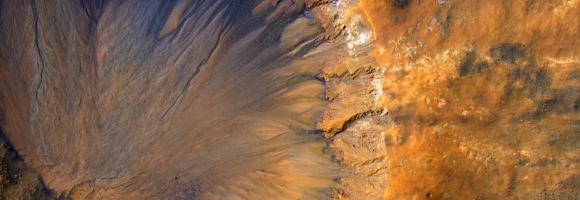 We, residents of a blue marble of which 71% is covered by water, have long assumed that the rest of our solar system was relatively dry. It may be time to change that opinion. Yesterday, NASA announced strong evidence of liquid water on Mars. “Mars is not the dry, arid planet that we thought of in the past,” said Jim Green, director of planetary science at NASA Headquarters, in a press conference on Monday. Mars apparently has seasonal rivers of flowing briny water. Mars was once at least partially covered in water. “If we go back 3 billion years and take a look at Mars, Mars was a very different planet. It had what we believe was a huge ocean, perhaps as large as two-thirds of the northern hemisphere,” said Green. “But something happened. Mars suffered a major climate change and lost its surface water.”
We, residents of a blue marble of which 71% is covered by water, have long assumed that the rest of our solar system was relatively dry. It may be time to change that opinion. Yesterday, NASA announced strong evidence of liquid water on Mars. “Mars is not the dry, arid planet that we thought of in the past,” said Jim Green, director of planetary science at NASA Headquarters, in a press conference on Monday. Mars apparently has seasonal rivers of flowing briny water. Mars was once at least partially covered in water. “If we go back 3 billion years and take a look at Mars, Mars was a very different planet. It had what we believe was a huge ocean, perhaps as large as two-thirds of the northern hemisphere,” said Green. “But something happened. Mars suffered a major climate change and lost its surface water.”
Mars, however is not the only damp spot off our planet however. Scientists now believe that Jupiter’s largest moon, Ganymede, has an underground ocean that contains more water than Earth’s, broadening the hunt for places in the solar system where life might be able to exist. Also in October, we posted that the European Space Agency has detected water vapor on Ceres, the largest and roundest object in the asteroid belt. they estimate that it may contain more freshwater than all of Earth. There is also evidence of water on Pluto.
And if our solar system is relatively damper than we might have expected, where did the water come from? A team of scientists from the University of Michigan now believe that up to half the water on our planet is older than the sun. If that is the case, then water may be more universally common that we might have thought. If we are correct that water is an essential element of life, then life, like water, may also be more common in the universe than we had imagined.
